Gran Turismo 4 Import Preview
We take another detailed look at the Japanese import version of Gran Turismo 4.
Wouldn't it be nice if all you had to do to drive the most luxurious high-performance cars in the world was to buy a beater and win a few races? For years now, this has been the central recipe for success in Polyphony Digital's Gran Turismo series: win races to win money to buy better cars to win more difficult races. Whatever its limitations, this formula has worked for the series, as the GT franchise has enjoyed phenomenal success worldwide and spawned numerous copycat games over the years. With the Japanese import version of Gran Turismo 4 currently making the rounds at the GameSpot offices, we wanted to sit down and take a look at the game's simulation mode.
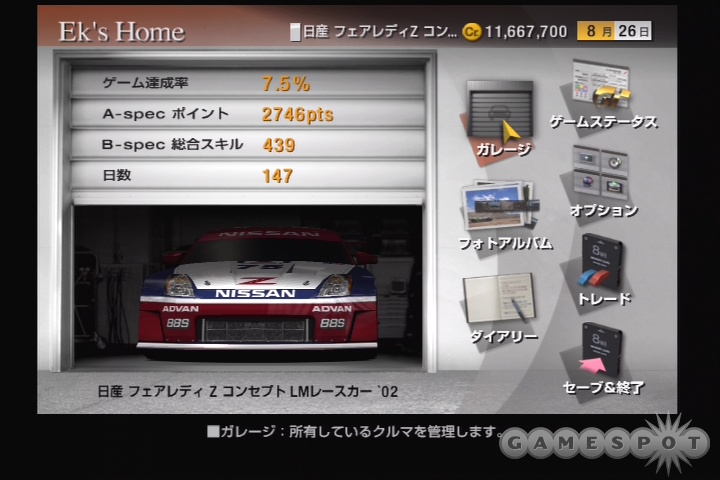
When Gran Turismo 3: A-Spec hit the streets in July 2001, gamers were blown away by the PS2-powered visuals, which were stunning to behold and, at that time, the best example around of the next-generation console's pixel-pushing power. After some time with the game, however, it became apparent that while GT3 looked and played great, it was a bit light on content, especially when compared with the massive two-disc Gran Turismo 2, released in late 1999. While GT2 featured more than 400 car models, GT3 included only 150. Gran Turismo 4 looks to trump all previous versions of the game, however, boasting more than 700 cars from more than 80 manufacturers. It was with these huge numbers in mind that we began our exploration of GT4's simulation mode.
After booting up the game for the first time, we were excited to see that we'd be starting off our Gran Turismo career with 1 million credits in our pocket. That is, until we figured out that the 1 million Japanese-yen-based credits were roughly equivalent to what many Tokyo school children spend on a school lunch. Despite our paltry financial beginnings, we were certain grand things were ahead for us as we embarked on our quest for automobile greatness. With such a meager amount of cash, the only affordable cars that would give us a shot at winning a race would be found in the used car lots. On the main GT4 simulation world map, there are two locations to purchase used cars: used cars '90s A and used cars '90s B. Had we wished to go a bit more old-school with our first purchase, we could have entered the so-called "old timer" section to find an assortment of affordable '80s-model rides. In the end, however, we settled on a mid-price 1991 Nissan Skyline GTS-t Type M and headed out to earn a license or two.
The license tests, another mainstay of the GT series, return in GT4. Like in Gran Turismo 3, there are five sets of license tests--A, IB, A, IA, and S--and each set consists of 16 individual driving events. Just as in previous installments in the series, these driving events range from simply braking within a specified zone after a long straightaway, to navigating complex series of turns within an allotted amount of time. Events take place on courses found throughout the game--including city streets and the famed Nürburgring--and in a multitude of cars.

However, the license tests do have a couple of new twists this time around. The first is the introduction of a pace car in some of the events. During these events, the pace car drives ahead of you for one full lap, during which you are not allowed to overtake it. Do so, and your license test will be over and you'll be required to start over from the beginning. This can be tricky, especially on courses you are not familiar with, as the pace car displays the typical early-braking tendency found in the Gran Turismo series' AI, making it easy to overshoot the pace car if you aren't careful. What we haven't been able to figure out in these pace-car tests is just how to achieve a gold or silver medal without passing the pace car. It's unclear whether or not the pace car runs at a pace that's relative to your own (thus allowing you to achieve gold or silver status by simply improving your lap times).
The other new license-test wrinkle is the coffee break, so called because of the cup-of-joe icon denoting each test. Each license includes one coffee-break trial, which typically consists of either avoiding orange road cones on your way to the end of a course, or knocking down a string of road cones configured in a winding design. While you can still earn gold and silver designations for completing these "relaxed" challenges in a certain period of time, there is no minimum time to beat to earn the bronze medal. Simply making it to the end of the course, or knocking down all the cones--no matter how long it takes--will be enough to pass the test.
Racing Around the World
After grabbing a few licenses, with bronze medals across the board (there will be plenty of time for silver- and gold-medal mining later), we wanted to take our little Skyline onto the track and start earning some scratch. Back to the main world map we went, where we found races grouped into "halls" scattered all over the main screen. These halls are organized according to a number of restrictions, mostly either by license qualification--beginner hall, professional hall, and so on--or region of origin. Races in the Japanese hall, for example, are restricted to cars from the game's 12 Japanese manufacturers. Competitive halls for both American and European autos are also included in the game. The halls aren't simply organized by region, however, as you'll find grouped races organized by a number of specific conditions such as the endurance hall, the extreme hall, the special conditions hall (for the game's 33 rally-race events, including ice and snow rallies), and the mission hall (where you complete a number of missions--such as overtaking a single car identical to your own--on a variety of courses to gain credits).
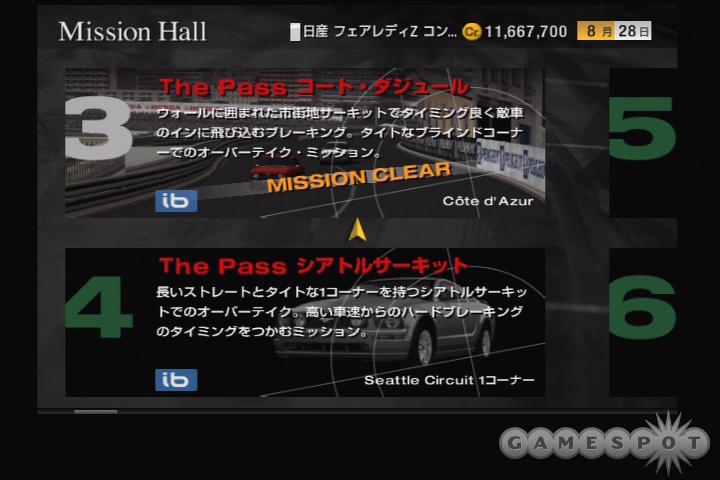
As we were just starting out, we felt the obvious place to begin was the beginner hall, which houses eight race events, including the familiar Sunday Cup; the FF, FR, 4WD, and MR Challenges; the K Cup, the Spider and Roadster Series; and the Sport Truck Race. As you might expect, some series within a particular competitive hall have their own restrictions. The 4WD Series, for example, is only for four-wheel-drive cars, while the Sport Truck Race has its own similarly obvious parameters. Each series in the beginner hall consists of five individual races. Win the races and you'll earn cash; win all the races in a series and you'll get that most welcome bonus--a new car for your garage.
After a few series races, it became obvious that our plucky little '91 Skyline was light on horsepower, probably a bit too heavy, and hampered by lousy brakes. A quick trip back to the main world map and over to the Nissan dealership and we found our Nismo tuning shop, where we could purchase a number of car upgrades with the money we'd earned in our race wins. It's worth mentioning that the main world map has a helpful navigation feature that denotes your current car's appropriate regional hall on the map. Once you're in that regional hall--in our case, the Japanese hall--the specific manufacturer of your current car is denoted with a gold car icon. This handy reminder is a welcome assist if you've been away from the game for a while and forgotten which car you're currently driving.
With a few hundred thousand credits burning a hole in our pocket, we knew what we needed to trick out our trusty Nissan, even if we couldn't read the Japanese writing denoting each specific part type. Anyone familiar with the upgrade icons found in previous installments in the GT series will feel right at home here, at least in the main screens. While choosing between one of three muffler types was not a problem, especially when the horsepower benefits of each part were explicitly spelled out, picking between the multitude of different transmission components was more complex. Still, all the upgrades found in previous versions of the game were there for the buying, including brakes, engine, exhaust, transmission, suspension, tires, and so on. Because our funds were limited, we settled on upgraded brakes, an improved exhaust system, and a stage-one weight reduction.
Our wallets now as light as our newly upgraded car, we immediately headed back to the tracks to try a different event in the beginner hall. In previous races, we had been concerned with the tendency of the GT4 AI drivers to drive like gangbusters on the final lap, providing a challenge toward the end of a race, even if you'd built a substantial lead in the opening laps. With our upgraded sled, we knew we'd be able to take advantage of the old Gran Turismo mainstay tactic: Might makes right. In other words, with the right combination of upgraded parts, or a few performance tweaks, you can easily outclass practically any opponent in the game, even if your driving skills are found lacking. Use this tactic over the course of a few race series and you'll soon have a bank-account balance that's impressive no matter what form of currency you're using.
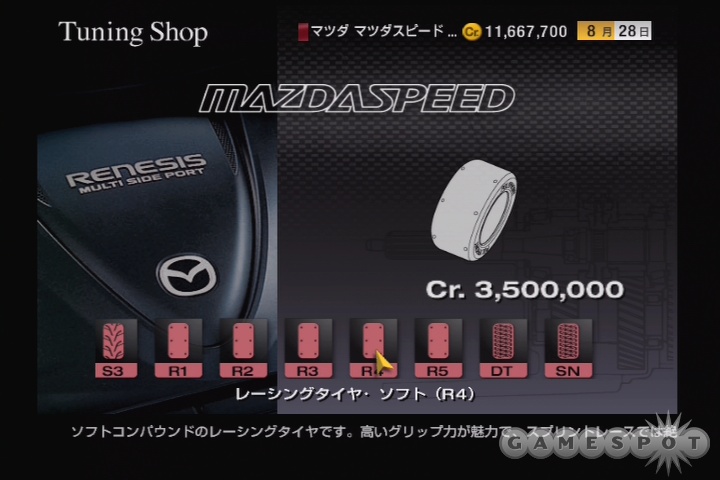
So what do you do with all that extra cash? If you're anything like us, you'll go straight to the dealerships and start filling up your garage with a lineup of your dream cars. The improved garage interface allows you to filter your cars through a number of different criteria. Not being able to read the Japanese text describing most of the cars, we found the drivetrain filter especially helpful when trying to find an appropriate car for a front-wheel drive race, for example. Supposedly you can also filter your garage--which can accommodate several hundred automobiles this time around--according to manufacturer, and make a "favorites" list of commonly used cars, but the language barrier prevented us from testing either of these features.
Feeling Right at Home
Races in the import version of Gran Turismo 4 will feel familiar to fans of the series--especially where the opponent AI is concerned--though a few noticeable tweaks have been made. While it is still possible to "bumper-car" your way to the head of a race within the first few turns (assuming your ride has the muscle), we noticed several instances of the AI racers battling for position in our rearview mirror. Once again, AI-controlled cars seem to generally follow similar racing lines--though, to be fair, we noticed some cars actually go off line and kick up dust on some tracks. As has always been the case with the series, your main competition in GT4 will be against each car's unique, realistic handling--which provides for a challenge each time you sit behind the wheel--and against yourself, as you look to beat old records in the quest to add zeroes to your bank account.
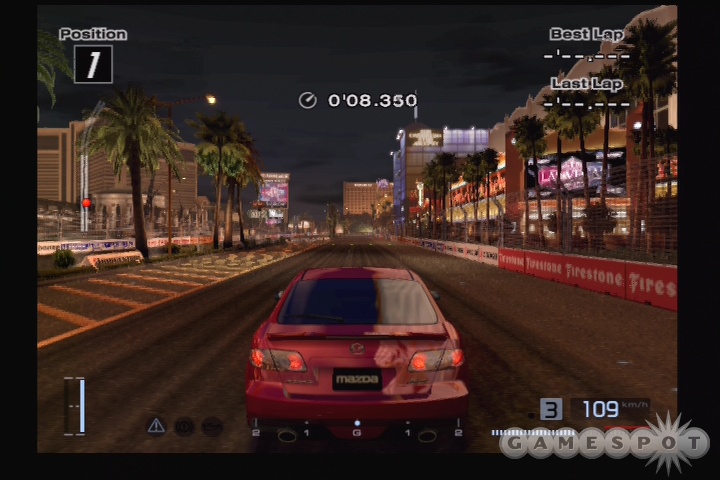
Here's an interesting aside: Even as we are writing this paragraph, we're winning a seven-lap professional race at Laguna Seca. In fact, we've won six straight races despite barely touching the PS2 controller. How did we accomplish this, you ask? The answer is simple: Gran Turismo 4's B-spec mode, a basically hands-off driver-management mode that allows you to "coach" your car through a race and around your competitors. If you've read our previous impressions of the import version of GT4, you're already familiar with this mode. You know that you can control your driver's pace by choosing a number between one and five with the directional pad--one being a very conservative style of driving and five telling the driver to push extremely hard around the track. You know that you can tell your driver when to attempt an overtaking maneuver simply by pressing the triangle button, and that you can even notify your driver when to enter the pits for a tire change and splash of fuel during endurance races.
What you may not know about is the B-spec mode's race-monitor screen, accessed by pressing the R1 button during a race. Here, you get a full summary of the current race, including your position relative to all five of your competitors, sector times, tire and fuel status information, and distance between yourself and the cars around you. There's also a letter above your car that is presumably tied to your position at the start of the race. The race-monitor screen feels more like the kind of information a race-team manager would be seeing during a real-life race, and is a welcome alternative to the standard replay viewpoint found in the B-spec mode.
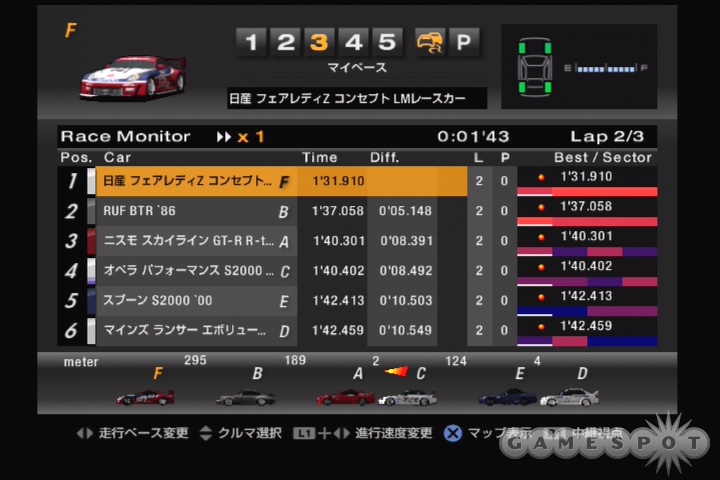
After winning a hands-off series in the B-spec mode, due to the sheer power of our Nissan Z decked out in full race trim, we decided to get back behind the wheel to find out exactly what our car could do when it was really opened up. Gran Turismo 4's world map provides several places to test your car's capabilities, including the power and speed hall and the driving park. In the power and speed hall, you can either take your ride out on the massive driving park test oval, or put your acceleration to the test on the Las Vegas drag strip--a short blast of a ride down the neon-saturated Las Vegas main thoroughfare. In the driving park, you can take your auto through various configurations of the aforementioned driving park test course. While each trip to the test course will cost you 500 credits, that's a mere drop in the bucket once your career really starts rolling. If you tire of driving in straight lines or circles, you can take your car out on any of the real and fictional courses found in the game, by accessing the original course or real circuit halls on the world map.
If you're looking for a break from the breakneck speed, you'll be able to get in touch with your creative side using the game's photo mode, which allows you to take a picture of any car in your garage in one of a number of picturesque settings found in the game, including real-life locations such as Times Square, the Grand Canyon, Piazza San Marco, and Shibuya. The photo mode controls take a bit of getting used to, and the mode limits where you can place your camera and vehicle within the surroundings. With a bit of practice, however, you'll learn how to efficiently place your car within the gorgeous photo-realistic environments to get the most dramatic shots possible. With comprehensive camera controls such as tilt, aperture, zoom, and height, as well as the ability to adjust minute details on your car like tire direction, amateur shutterbugs should have a ball with this mode. You can easily access your saved photos and replay movies from your garage "home page" to show off to your friends or even print out, provided you have a USB printer handy.
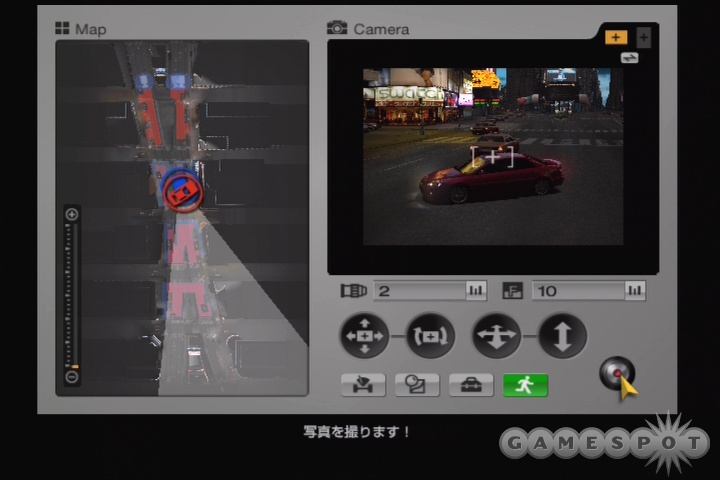
All in all, the biggest gains to be found in the import version of GT4 are measured in terms of sheer quantity. It may be unfair to tag Gran Turismo 4 as "GT3 with a lot more content," but that's the impression we've gotten so far from the import version. The game's massive roster of automobiles, attractive mix of gorgeous real-life and fictional courses, loads of customization options, and game modes galore means that, when it arrives on US shores later this year, gearheads across the nation will be happily facing numerous sleepless nights. We'll have more coverage of Gran Turismo 4 in the coming weeks as we prepare for the game's US launch.
Got a news tip or want to contact us directly? Email news@gamespot.com
Join the conversation